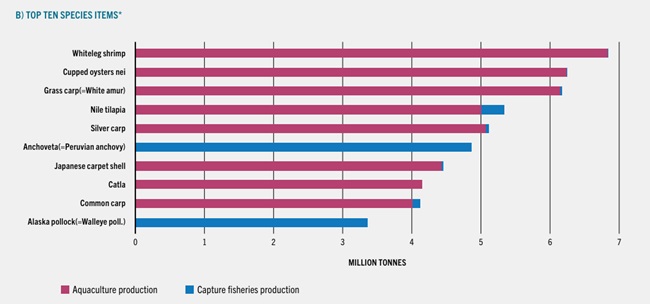(Preliminary Exam: Current National and International Events)
(Main examination, General Studies Paper- 3 : Animal Husbandry Economics) |
Reference
According to the Food and Agriculture Organisation (FAO)'s 'The State of World Fisheries and Aquaculture (SOFIA) 2024' report, India has joined the list of top fish producing countries in the world.
Status of Aquaculture and Fish Production in India
- India is the third largest fish producer in the world and the second largest aquaculture producer after China.
- China ranks first and Indonesia ranks second in fish production.
- India has achieved a record fish production of 175.45 lakh tonnes in the financial year 2022-23 which is 8% of the global production.
- It contributes about 1.09% to the country's Gross Value Added (GVA) and over 6.724% to the agricultural GVA. The sector supports the livelihood of over 28 million people in the country.
About SOFIA Report
- It is a flagship report of the Food and Agriculture Organisation (FAO) that analyses the status and health of global fish stocks, as well as trends in fisheries and aquaculture at the global and regional levels.
- The 2024 edition highlights the solid progress made by the Blue Transformation initiative and demonstrates FAO’s role in driving transformation towards sustainable aquaculture expansion and intensification, effectively managed fisheries, and life chains that prioritise efficiency, security and equity.
SOFIA 2024 statistics
global Production
- Fisheries and aquaculture production: 223.2 million tonnes
- Aquatic animals: 185.4 million tonnes
- Algae: 37.8 million tonnes
- Aquaculture production: 130.9 million tonnes
- Capture fisheries: 92.3 million tonnes
- Aquatic animal production by region: Asia (70%), Europe (9%), Latin America and the Caribbean (9%), Africa (7%), North America (3%) and Oceania (1%)
- Main producers of aquatic animals by country: China (36%), India (8%), Indonesia (7%), Vietnam (5%) and Peru (3%)
consumption
- Global apparent consumption of aquatic animal foods (2021): 162.5 million tonnes
- Global apparent consumption of aquatic foods per capita (2021): 20.6 kg
- Global apparent consumption of aquatic foods per capita increases from 9.1 kg in 1961 to 20.6 kg in 2021.
employment
- People employed in primary production: 61.8 million
- Workers by sector: Fisheries (54%), Aquaculture (36%), Sector not specified (10%)
- Percentage of jobs by region: Asia (85%), Africa (10%), Latin America and the Caribbean (4%), Europe, Oceania and North America combined (1%).
Business
- Top exporters of aquatic animal products: China, Norway, Vietnam, Ecuador, Chile
- Top importers of aquatic animal products: United States, China, Japan, Spain, France
- Value of international trade in aquatic products: US$195 billion
Key points of SOFIA report
increase in total production
Global fisheries and aquaculture production is projected to grow by 4.4% by 2020.
Increase in Aquaculture Production
- According to FAO's SOFIA report, for the first time in the world, aquaculture production has exceeded fish produced from conventional fisheries.
- Aquaculture production in 2022 was unprecedented, reaching 130.9 million tonnes, of which 94.4 million tonnes were aquatic animals.
90% of fish production in 10 countries
According to the report, China, Indonesia, India, Vietnam, Bangladesh, Philippines, South Korea, Norway, Egypt and Chile are among the 10 countries where 90% of the world's fish production takes place.
Katla species included in top ten
- In terms of fish production in the year 2022, the Katla species ranked eighth in the list of top ten species.
- This species was initially found in North India, the Indus plains and the adjacent hilly rivers of Pakistan, Bangladesh, Nepal and Myanmar. Later, it was spread to all the rivers and reservoirs across India.

|
Also know this!
National Fish Farmers Day is celebrated every year on 10th July in India.
|
Major concerns highlighted in the report
The growing trend of indiscriminate fishing
37.7% of fish stocks in the world’s marine fisheries were identified as being fished unsustainably in the year 2021. In the year 1974, this figure was only 10%.
Increase in consumption
- Global consumption of aquatic life foods is set to reach 165 million tonnes in 2022.
- This figure has grown at almost twice the rate of the world population since 1961. Global per capita annual consumption has increased from 9.1 kg in 1961 to 20.7 kg in 2022.
- Of the top 10 marine species consumed by humans, 80% are being exploited unsustainably.
Regional inequality
- At present, only a few countries dominate aquaculture. 90% of global aquaculture production takes place in Asia while only 1.9% is produced in Africa.
Food Challenge of the Future
- This 2024 report presents scenarios for aquatic food supply up to the year 2050.
- To maintain 2022 levels of aquatic food consumption by 2050, total aquatic food supply would need to increase by 22%.
Blue Transformation Initiative
FAO has proposed a series of actions designed to build resilience in aquatic food systems and develop fisheries and aquaculture sustainably so that no one, especially communities dependent on the sector, is left behind. This initiative is called the Blue Transformation Initiative.
This initiative has three main objectives:
-
- First, to sustainably grow aquaculture, with a target of a 35% increase by the end of this decade.
- Second, improve fisheries management to ensure that 100% of fisheries in the marine environment and inland waters are subject to appropriate management measures.
- Third, develop the value chain of aquatic food products by reducing losses, adding value to the product and facilitating access to markets and consumers.
|



